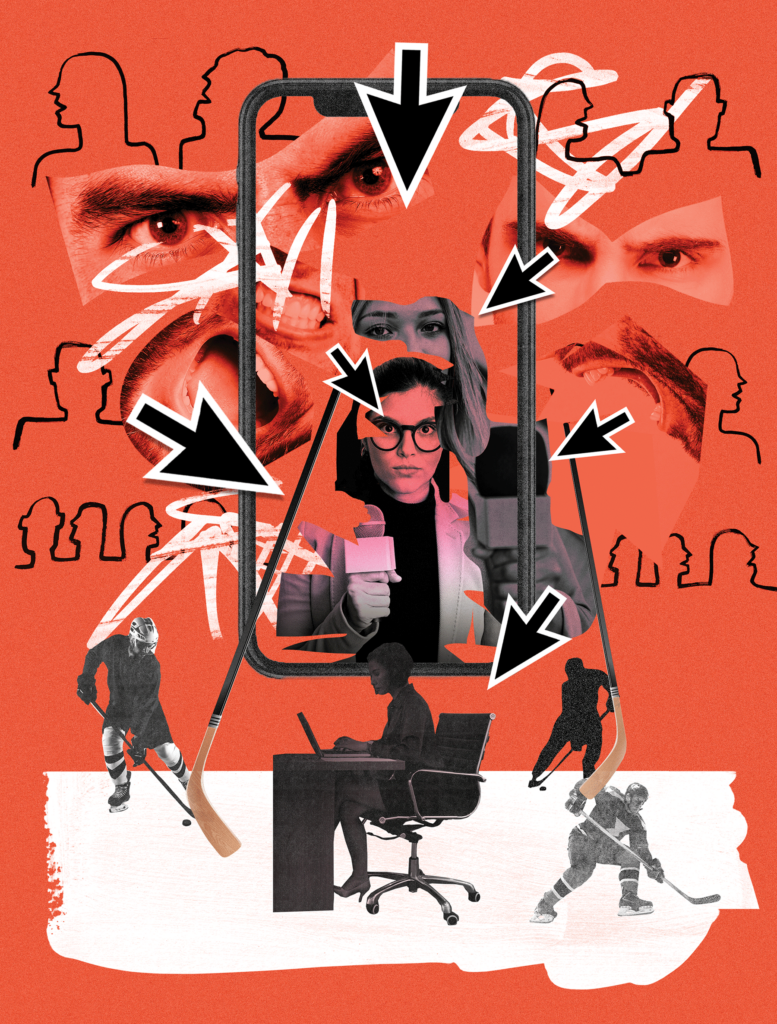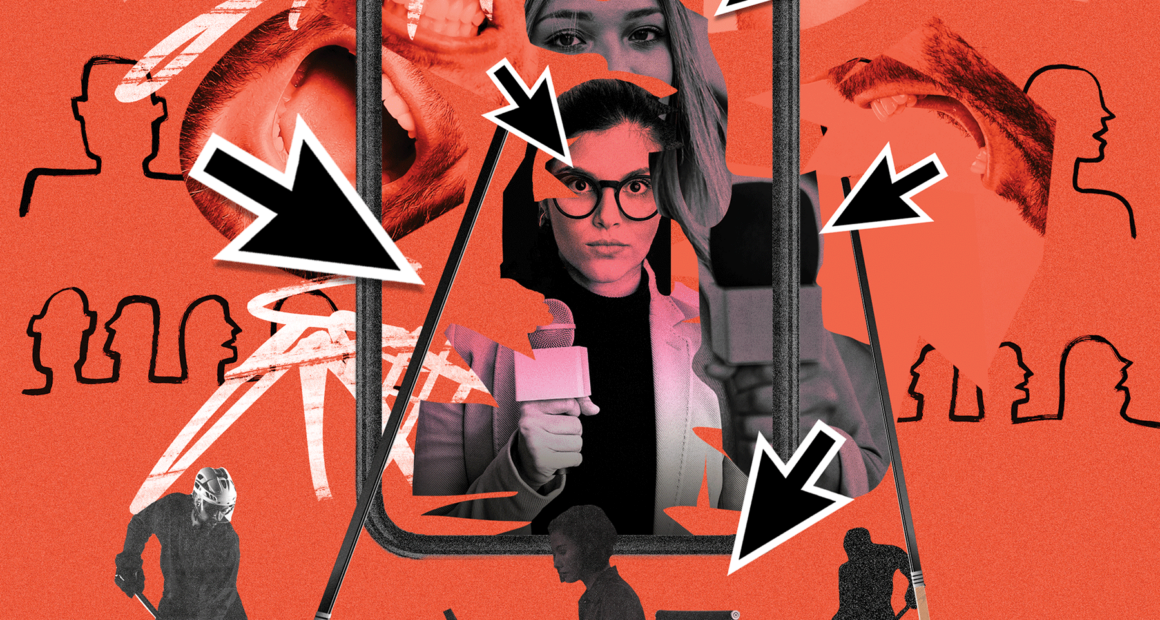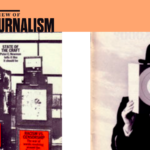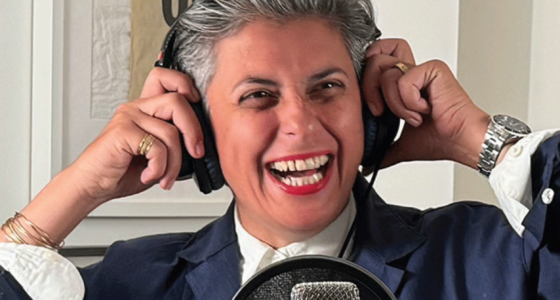Female sports journalists are living their dreams—except for the hate, threats, and online harassment

Illustration by Franziska Barczyk
By Tara De Boer
Leah Hextall was on a high. The sports journalist was just about to close out the biggest season of her career, her first as one of ESPN’s full-time National Hockey League play-by-play broadcasters. Hextall had been on the road the entire month of May, breaking for only a few days between calling big-time games in the first round of the 2022 Stanley Cup playoffs—games that turned out to be pivotal for Canadian hockey fans, with the Edmonton Oilers and Calgary Flames renewing their Battle of Alberta. She was making history as the first woman to hold a regular position calling play-by-plays for an NHL playoff game. It was a milestone she didn’t care to be publicly celebrated, though. She just wanted to do her job without drawing attention to herself.
Following one of her last nights on the road, Hextall returned to her hotel room, feeling good about the performance she’d given in the booth that night. “If I was going to give myself a grade, I would say I got a 97,” says Hextall. She’d just covered four games in six days, across three different high-stakes series. She’d only dreamt of being this busy and in demand. She used to spend her weekends annoying fellow fans in the bleachers of American Hockey League games, calling the play-by-play and recording it for practice, all the while holding down a full-time job as director of events and multimedia for the premier of Manitoba to make a living.
By this point in late spring, Hextall had already disabled most of her social-media notifications. She didn’t want to give any airtime to the usual post-game storm of online abuse. But when she returned to her room, an email marked unread was waiting in her inbox. “If they really want to,” she says, “they will find a way to get you.” Alone in her hotel room, Hextall clicked open the email: “You live in Winnipeg it wouldn’t be very hard to track you down. And when I do, I will come in and I will stick my hard cock in your mouth so that I don’t have to hear you anymore. And when I’m done with you, I will then put a gun in your mouth and blow out your brains, so no one has to hear you call a hockey game again.”
Hextall’s reaction was to delete the email—but the damage had been done.
For Hextall, hockey has always been the friend with whom she felt most comfortable. It’s also in the family blood. Her grandfather played right wing in the NHL and was inducted into the Hockey Hall of Fame in 1969. Two uncles, one a centre, the other a left winger, had lengthy careers in the NHL. Her cousin was a long-time Philadelphia Flyers goaltender, won the Vezina Trophy (awarded to the goalkeeper deemed best at the position) in 1987, and is the current general manager of the Pittsburgh Penguins. When she finally won her own seat at the table, on the broadcast side, the fact that the room was so male-dominated felt off. The sense of belonging wasn’t there.
After reflecting on her first season with ESPN, Hextall, now 43, mulled over how she would survive within a culture dominated by men. “Things haven’t changed at all since I started 20 years ago, when I was the only woman in the room. I thought: This message [about having more women in the field] needs to get people at the start, not the finish. And I considered the NHL to be the finish.”
Hextall contacted the Coaches Site, an online destination for news and information about coaching, as she knew there would be coaches there working at the grassroots level. She noticed the site had an upcoming conference, and by summer 2022, she was standing on stage, overlooking a crowd of mostly men, reading out those painful words in the email publicly for the first time.
In her 27-minute speech, “Not One of the Boys,” Hextall spoke to listeners about her own way into the industry, why networks need to hire more intentionally, and what harassment looks like. The feedback was overwhelmingly positive, even though not everyone agreed with what she said. One man approached her afterward to say that he still doesn’t like hearing a woman broadcasting the game of hockey but added that Hextall’s story reminded him of his own daughter and her career aspirations. “I didn’t take offence to that,” she says. But when Hextall’s presentation was featured in a story in The Athletic by Sean Fitz-Gerald, a flood of hate was directed at her on social media. “Sean did a great job,” says Hextall, “but I knew people would read the article and not watch the presentation,” which contained more context. Under the story, many commenters said she wasn’t being criticized for being a woman, she was being criticized for her performance. Hextall anticipated this kind of reaction. “I got people emailing me telling me I’m a coward because of my perspective,” she says.
Hextall had gambled. She had cooperated with Fitz-Gerald because the story would reach more people. She took herself offline the day it was published to avoid the inevitable social media toxicity. Hundreds of messages were posted in the story’s comment section—some supportive, others less so: “The abuse is obviously gross and unacceptable,” wrote one reader, “but plain and simple Hextall isn’t an NHL quality announcer and audiences don’t owe her any patience as she figures it out.”
“I don’t regret doing the article,” she says. “But there’s a little bit of me that still wishes maybe I hadn’t done it.”
While Hextall is accustomed to online harassment, she says it can affect her mentally when she shows up to do her job. Messages that are critical of her voice are especially discouraging. “What’s consistent is the criticism is followed by something with my gender attached to it. [T]he comments about my voice are sexist,” she says. “Is the voice really that bad? Or does it just sound female?” she wonders. “If we don’t allow women to sound female, are we ever going to get there?”
Hextall’s encounters with sexism in the workplace, dating back to when she broke onto the scene in 2003, is a story all too familiar for other women in sports journalism. But one thing was different back then. The beast of social media did not yet exist. “Thank goodness for that,” she says, “because I don’t know if I would have survived.”
Almost 20 years later, public scrutiny and gender discrimination within the industry persist. With increased access between journalist and public through social media, the issue has grown exponentially. A 2019 study by the Internet Health Report found that two-thirds of female journalists had experienced online harassment, and while social media may have increased opportunities for connection, self-branding, and jobs for reporters, it also opened the floodgates for derogatory, violent, and scathing reviews of women on the job. “It’s never here and there,” Hextall says. “It’s every time I step into the booth. I have 10 of those kinds of emails sitting in my inbox right now from after my last game.”
“Is my voice really that bad? Or does it just sound female? If we don’t allow women to sound female, are we ever going to get there?”
Six years ago, the social media movement #MeToo exposed rape culture, along with instances of sexual abuse and harassment of women worldwide. It’s been more than 60 years since the women’s liberation movement, which fought for equal rights and opportunities for women in starting in the 1960s. And while ongoing efforts toward gender equality are leading to some shifts in culture and policy in North America, sports journalism is still in a time of firsts for women.
TSN’s Kayla Gray became the first Black woman to host a flagship sports highlight show in Canada when she launched The Shift in 2020. One year later, Gray, alongside a group of four other sports analysts and reporters—Amy Audibert, Meghan McPeak, Kia Nurse, and Kate Beirness—made history as a broadcast team of all women as they covered every aspect of a Toronto Raptors–Denver Nuggets game—an NBA first, according to CTV.
Another trailblazer is Amrit Gill, who became the first woman on Hockey Night in Canada: Punjabi Edition. Gill, a Vancouver-raised broadcaster and hockey aficionado, was preparing to appear on a Hockey Night in Canada segment for the first time in February 2021. After excitedly tweeting a photo of herself sitting at the shiny broadcast table, pages of highlighted notes in front of her crossed hands, in came dozens of responses of uninvited and crass sexual remarks, comments on her appearance, and inappropriate objectifying pick-up lines.
“Being a woman in sports media is hard,” Gill wrote in a note she shared on Twitter following the events. “For women of colour, there can be an even greater internal battle that exists, often resulting in uncertainty not only about their self-worth but their future in the industry as well. That’s why we see so few females from diverse backgrounds choosing to pursue a career in sports journalism.”
While careers in sports journalism have become more accessible to women, the number fulfilling these roles remains a fraction compared to men. According to a report from the Institute for Diversity and Ethics in Sport (TIDES), as of 2021, only 14.4 percent of sports reporters in the U.S. and Canada were women. The landscape is even worse for women of colour. A whopping 70 percent of sports editor positions are still represented by white males, according to the TIDES 2021 Sports Media Racial & Gender Report Card, which evaluated more than 100 newspapers and websites to measure changes in racial and gender hiring practices since its last study in 2018.
One sports journalist who has faced her fair share of online harassment at the intersection of gender and race is Shireen Ahmed, a freelance journalist and a journalism instructor at Toronto Metropolitan University (TMU). “Experiences of racialized folks or women are completely ignored from that menu. Not only have I gotten sexist, misogynist comments or messages, I’ve gotten gendered Islamophobic harassment and racism, xenophobic commentary,” she says. “Rape jokes are universal, but we all get some very specific things about being deported.”
In 2021 Ahmed received a death threat that required involvement from the police. She was also offered institutional security by TMU as a safety measure, though this proved unnecessary due to COVID-19. “The authorities told me that their studies on online abuse show that it seldom results in actual violence. That’s not something I’m interested in banking on, particularly when more anti-Muslim-women sentiment is circulating in this country. I can’t hide my identity. I’m a racialized woman, and I wear a hijab. It’s not like I can blend in like other white people at the arena.”
When Ahmed started working at CBC Sports, she texted her editor that the messages and comments were getting particularly bad on a recent story she had covered. He was apologetic. He had not been monitoring them as closely as he would have liked, explaining that it was difficult to keep up with managing the comment section on top of his regular work. “When people started building this industry, they didn’t think of incorporating someone to monitor commentary so that racialized women wouldn’t get harassed,” Ahmed says. She believes now is the time for the job of monitoring comments to be prioritized.
There’s an extra level for women of colour. “Rape jokes are universal, but we all get some very specific things about being deported”
The growth of social media came at a time when news outlets were shifting their news distribution to keep up with rapidly evolving technological innovation. Twitter made it simple to share headlines instantly, interact with people across nations, and connect with sources worldwide. Due to this innovation, the platforms have grown as discussion spaces for the journalism community itself. The accessibility and branding aspects of social media have made it a strategic tool for journalists to get more eyes on their work, report in real time, and even network within the industry. For many, it’s a tool to maintain currency. But in less positive instances, the platforms become a stomping ground for discriminatory discourse and showcase an overwhelming imbalanced ratio of male to female sports journalists in the industry.
In 2016, American sports journalists Julie DiCaro and Sarah Spain were featured in a video in which men read tweets that were directed at the women aloud. The tweets became progressively more violent as the four-minute video continued. One user wrote that he hoped DiCaro was Bill Cosby’s next victim, and death threats were directed at Spain. The piece ends with a statement: “Some women in sports are harassed online just for doing their jobs. You wouldn’t say it to their faces, so let’s not type it.”
Since then, Instagram, Twitter, and TikTok have all increased their user counts. But why, if social media can be so toxic, don’t people simply deactivate Twitter or vanish from Instagram? That’s not an easy decision for any journalist to make, given the overall importance of social media. In fact, more than nine in 10 journalists in the United States use social media for their jobs, according to a recent Pew Research Center survey, with Twitter being the number-one platform for those in journalism.
For Ahmed, having social media is a no-brainer. She gets frustrated when people suggest she could just hit delete to avoid the hate. “I created my career off of social media,” she says, adding that Canadian sports writers who don’t have to rely on social media are “incredibly privileged.”
“I needed those networks, I needed to make those connections and the networking opportunities that Twitter and LinkedIn and IG afforded me….Saying, ‘Just log off,’” she continues, “is like saying to a carpenter, ‘You know what, just leave your hammer,’ or ‘You don’t need a screwdriver—just be creative and use a knife.’ Yeah, no.”
As for Hextall, not a day goes by where she doesn’t think about getting rid of her social media accounts, though upon returning from her summer vacation, she reactivated her apps. She immediately felt those old anxieties creeping back. Yet, she stays on. “I don’t have to be on it—ESPN says we can bail anytime we want—but there’s something that makes me feel that I need to still be on it: Relevancy? The blue checkmark? The ‘I’m here’?”
While the experiences of Ahmed, Gill, and Hextall demonstrate the severe online harassment women in the industry can face, not all cases manifest this way. Meaghen Johnson, a women’s sports contributor for TSN and TSN.ca, says she’s extremely fortunate to have faced minimal online harassment so far in her career—especially compared to her peers covering men’s sports. However, she doesn’t think this is solely because she works in women’s sports. “For the most part,” she says, “you get trolls with the ‘No one cares about women’s sports’ comments, but not too much beyond that.”
As for the role of social media in her profession, Johnson sees it as a positive tool. “Overall, it’s beneficial,” she says. “There’s always the ‘hellscape’ aspect of social media. That’s not necessarily just bullying or abuse, but overreactions, misunderstood posts, etc. I don’t have a huge following, but the following I have accrued so far is largely due to being able to share my work on social media and have it circulated.”
Some organizations are working hard to diminish the discrimination women in sports media face. The Association for Women in Sports Media serves as a positive advocate for women in sports media. It offers support and acts as a watchdog for any gender injustice faced by female professionals in sports media. The Coalition for Women in Journalism supports women and 2SLGBTQIA+ people all around the world as they embark on their journalism careers. Founded by Kiran Nazish in 2017, the organization provides monthly reports on online harassment cases against women journalists. It also runs a solidarity campaign to support Canadian women journalists targeted by trolls.
It’s not surprising for Nazish, formerly a journalist in Pakistan, that online violence, misogyny, and other threats are increasing for women and 2SLGBTQIA+ journalists. “In the two decades of my career as a journalist and several years running a global organization that strives to protect women journalists when they are harmed, I find the most fundamental problem to be that of collective inaction in the face of violence. As an industry, collective action in the absolute—or significant—sense is critical for us to tackle an issue that is crushing us.” While all newsrooms are different and every scenario is nuanced, Nazish thinks there are a few ways for newsrooms to better support their women. “We recommended newsrooms to begin with a regular meeting with staff about their experience with online harassment and come up with policies and resources that will help tackle the problem as needed.”
Nazish believes that to respond to harassment appropriately, it is critical that an organization first understand what sort of response is required—even before journalists report on sensitive topics. Online violence, she thinks, poses risks to the emotional well-being of journalists, opens them up to possible physical attacks, and negatively affects the reputations of both the journalist and the newsroom. “We absolutely recommend a preemptive approach,” she says. “Digital safety and securing their devices, and mental health support, such as access to therapy and mental health consultations, are vital to ensuring the well-being of the journalist and the work they produce.”
This spring, Hextall embarks on her second season at ESPN with a lot of work still to be done to approach gender equity in sport. In her speech, she told her audience that they had the ability to make an impact by simply bringing more young female journalists into the profession on a day-to-day basis, “so that they can gain the experience to be the qualified candidate.” If that happens, she believes, conversations will start, thought will become more diverse, and both sides will benefit. Most importantly, she says, “We are going to move our hockey culture in the right direction.”
The “right direction” suggests a ray of hope. In the final lines of Hextall’s speech she addressed her aspirations for women in the industry: “For me, at my core, I get to do something that I love every day and that is a gift, and make an impact, by not being one of the boys.”









